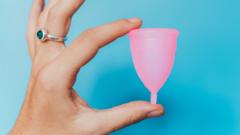In a recent alert issued by healthcare professionals, women have been urged to exercise caution when using menstrual cups, following an alarming case where one user experienced temporary kidney complications due to improper positioning of the device. The 30-year-old patient suffered from ongoing pelvic pain and traces of blood in her urine for several months, a condition she had not associated with her menstrual cup—a reusable product designed to collect menstrual blood.
Danish doctors, cited in the British Medical Journal, indicated that while such complications are exceedingly rare, an incorrectly placed cup can exert pressure on adjacent structures, such as the ureters, which transport urine to the bladder. The importance of selecting a suitably sized cup and ensuring proper insertion has been underscored by healthcare professionals. "Correct positioning, along with choosing the ideal cup shape and size, is critical to avoiding adverse effects on the upper urinary tract," they stated.
Menstrual cups are valued for being both reusable and environmentally friendly alternatives to traditional sanitary products. Made from soft silicone or rubber, they can hold between 20 to 30ml of blood and can be emptied and reused every four to eight hours, depending on the user’s flow. Each individual may find different cup models more suitable for their anatomy, with smaller sizes available for younger users or those who have not yet given birth.
However, earlier experiences may indicate that first-time users can find it challenging to remove the cup, often requiring assistance. After insertion, the cup forms a suction seal to prevent leaks, but users are advised not to pull directly on the stem during removal. Instead, they should pinch the base to break the seal and gently wiggle the cup free, explains Dr. Kate Lough, a physiotherapist specializing in pelvic health. “It may take several cycles to become comfortable with using one, and ideally, it should not cause any discomfort,” she reiterated.
To enhance safety, Dr. Lough recommends that users explore different shapes, sizes, and firmness levels available in the market to find their best fit. Additionally, women with recent contraceptive coils should be cautious, as there is a minimal risk of suction leading to displacement or removal of the device. In such cases, individuals are encouraged to consult healthcare professionals. Menstrual discs offer a similar function but are positioned higher in the vaginal canal, just under the cervix, providing another alternative for menstruating individuals.
Danish doctors, cited in the British Medical Journal, indicated that while such complications are exceedingly rare, an incorrectly placed cup can exert pressure on adjacent structures, such as the ureters, which transport urine to the bladder. The importance of selecting a suitably sized cup and ensuring proper insertion has been underscored by healthcare professionals. "Correct positioning, along with choosing the ideal cup shape and size, is critical to avoiding adverse effects on the upper urinary tract," they stated.
Menstrual cups are valued for being both reusable and environmentally friendly alternatives to traditional sanitary products. Made from soft silicone or rubber, they can hold between 20 to 30ml of blood and can be emptied and reused every four to eight hours, depending on the user’s flow. Each individual may find different cup models more suitable for their anatomy, with smaller sizes available for younger users or those who have not yet given birth.
However, earlier experiences may indicate that first-time users can find it challenging to remove the cup, often requiring assistance. After insertion, the cup forms a suction seal to prevent leaks, but users are advised not to pull directly on the stem during removal. Instead, they should pinch the base to break the seal and gently wiggle the cup free, explains Dr. Kate Lough, a physiotherapist specializing in pelvic health. “It may take several cycles to become comfortable with using one, and ideally, it should not cause any discomfort,” she reiterated.
To enhance safety, Dr. Lough recommends that users explore different shapes, sizes, and firmness levels available in the market to find their best fit. Additionally, women with recent contraceptive coils should be cautious, as there is a minimal risk of suction leading to displacement or removal of the device. In such cases, individuals are encouraged to consult healthcare professionals. Menstrual discs offer a similar function but are positioned higher in the vaginal canal, just under the cervix, providing another alternative for menstruating individuals.



















